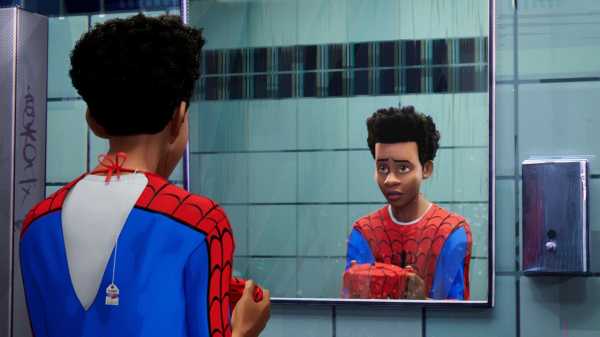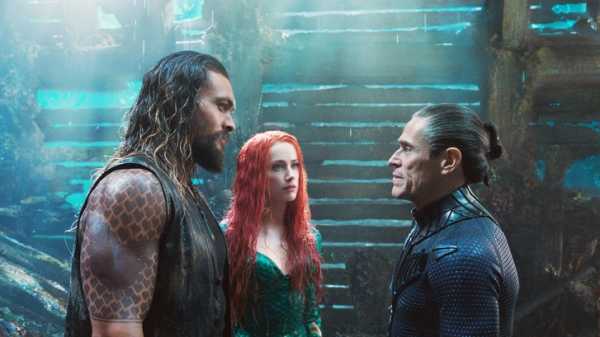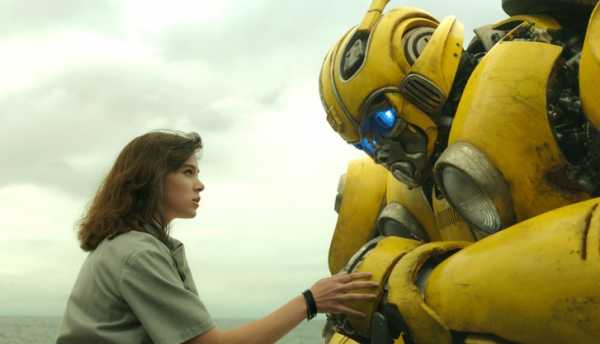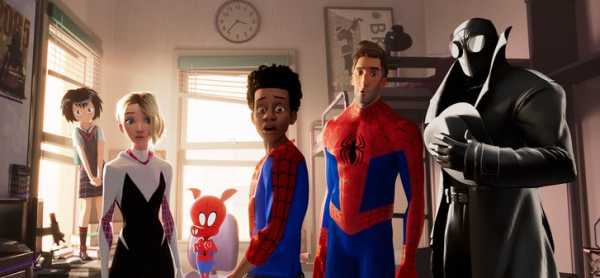
Through the vast complexity of their imagined universes and through their iconic status in mass culture, superhero-comic stories have morphed into a secular religion. That’s why fans’ reaction to criticism reaches a pitch of aggrieved dignity: if a movie has been admitted into the circle of canon, negative views of the movie are received as a rejection not merely of fans’ taste but of their belief system. (And movie studios ignore fan service at their own risk.) As a comic-book-reading child, I didn’t care much about story and, years later, came to liken reading comics for their stories to buying Playboy for the articles. But the movies, meant largely for people who aren’t children, sacrifice sensory and aesthetic thrills for the earnestness of textual intricacy. With their aura of the sacred, superhero movies have also acquired an air of the sanctimonious and a fixation on doctrinal purity. New installments are often designed to satisfy the craving of the devout for fidelity to the underlying mythology—or for a mythology to adhere to.
This season alone offers plenty of evidence for superhero movies’ role as a surrogate religion—as in “Aquaman,” where the money line is “The king is risen.” The protagonist’s given name is Arthur, and the drama draws on Arthurian legend, replacing a sword with a glowing golden trident—albeit one that isn’t pulled from a stone but pursued like the Holy Grail and forged in an ancient variety of 3-D printer. The character has recently appeared in two other DC Comics movies; this is his first free-standing movie, and it’s appropriately clotted with the blend of backstory, exposition, character introduction, and general table-setting that’s euphemized as world-building. That’s why much of the film’s dialogue plays out like the reading of a board game’s rules while it’s being played, in stentorian tones borrowed from public-television historical dramas and Shakespearean filmstrips. It would have saved time and money to make the rules downloadable with the purchase of a ticket.
The director of “Aquaman” is James Wan, whose skill with effects was on big-budget view in “Furious 7.” In that movie, his whimsical way with vehicular catastrophe was an apt match for the plot’s red-meat bromanticism. But, with “Aquaman,” the franchise-founding mandate is different. “Aquaman” has some of the same apparent flaws of “Furious 7” without adding a new range of virtues; it’s an admirably ambitious, ludicrous failure. The movie is about Atlantis, the mythical vanished undersea kingdom, which, for the purposes of the movie, not only existed but exists and, to this day, thrives. The drama starts in 1985, when the kingdom’s queen, Atlanna (“Atlanta” with a Long Island accent), played by Nicole Kidman, washes ashore on the coast of Maine and is found and rescued by the lighthouse-keeper Tom Curry (Temuera Morrison). He teaches her the ways of earth (don’t eat the goldfish), they fall in love, and their son, Arthur, proves to have aquatic powers similar to those of his mother. But, when powers that be in Atlantis threaten Tom and Arthur, Atlanna heads back to the deep, promising to return when it’s safe.

Jason Momoa, Amber Heard, and Willem Dafoe, in “Aquaman.”
Photograph from Warner Bros. / Everett
Trained by a magus from Atlantis (played by Willem Dafoe, a great actor thrust into the unhappy realm of Bombastis), Arthur hones his superhero skills and rescues a Russian submarine from pirates, but he makes a mortal enemy of a surviving attacker (Yahya Abdul-Mateen II). Meanwhile, dry land is under siege from angry sea-rulers who, using tidal waves, give humans back their plastic garbage and warships. Yet Arthur, now in the company of Princess Mera (Amber Heard), from Atlantis, will both help to save life on land and reclaim his rightful place on the throne of Atlantis. Along the way, there are big battles—one wrecking Sicily, another in an underwater “ring of fire” (where’s Johnny Cash when you need him?), and many others in a series of adventures and conflagrations in exotic realms like the Kingdom of the Trench and the Kingdom of the Brine, names that sound scavenged from the “Honeymooners” cutting-room floor. Through it all, Jason Momoa, who plays Arthur, tosses off coyly bluff one-liners with understated humor that goes to waste in this bloated and sludgy movie.
There’s plenty of action to punctuate the sequel-priming framework, and that’s where Wan distinguishes himself—not for the better, unfortunately. The upside to the sacred dimension of superhero movies is the occasional attainment of awe, astonishment, sublimity. The cosmic element has offered some of the best moments in recent superhero movies, as in Joss Whedon’s “Avengers” movies, Zack Snyder’s “Man of Steel,” Scott Derrickson’s “Doctor Strange,” and Peyton Reed’s “Ant-Man”—moments that stood out amid these movies’ many mandatory figures of quasi-scriptural mythology. Wan reaches hard for such exhilarations, showing off a profuse tangle and tumble of designer sea creatures—swarms of fish, hordes of crustaceans, waves of serpents, and eruptive sea monsters. He depicts vast vaults of bones, a whale’s innards, and more pale-blue glows and sparkles than you’d find in the inspirational section of a shopping mall. The movie’s decorative elements are vast in quantity but monotonously distant, with little tactile sense or intimate urgency. The spaces are enormously, cavernously defined, but they serve as mere backdrops. “Aquaman” is as elaborate as it is tasteless; it brings to life a story that’s as grandiose as it is inconsequential. Wan works mightily to lend the stiff action flamboyant style, but his garish near-miss proves that there’s only a short misstep from the sublime to the ridiculous.
There is one reliable source for superhero sublimity, and it’s all the more surprising that it’s a franchise with no sacred inspiration whatsoever but, rather, of purely and unabashedly mercantile origins: the “Transformers” series, based on a set of toys, in which Michael Bay’s exhilarating filmmaking offers phantasmagorical textures of an uncanny unconscious resonance. Sitting through the stories and accepting the performances is the price of receiving, as if through a sensory mainlining, Bay’s images of an empty profundity that are a sort of substance in themselves. But this year’s installment, “Bumblebee,” allows for no Bay-watching: the director is Travis Knight, and, as even its title suggests, the movie is something of a departure from its predecessors.
“Bumblebee” replaces the playthings with a message: where other superhero movies offer a mighty mythology of mind-stunning scale, “Bumblebee,” lacking mythology, offers a modest and local moralism. The movie (written by Christina Hodson) is a coming-of-age melodrama in the guise of a toy action film. Though the title character is one of the Transformers (a robot that conceals itself in the form of a car), the main character is Charlie Watson (Hailee Steinfeld), a high-school student in California. She turns eighteen in the brief span of the story, which is set in 1987 and features a recurrently explicit tribute to “The Breakfast Club.” Charlie is a welcome, all-too-rare female protagonist in the genre, albeit one who’s more a set of traits than a coherent personality.
A talented mechanic who’s at work on a vintage Corvette in the family garage, Charlie is in mourning for her father, who died suddenly several years earlier. Her mother (Pamela Adlon), a nurse, has remarried; her new husband, Ron (Stephen Schneider), is caring but clumsy. The family is struggling financially, and Charlie—culturally punkish, unfashionably unslick, working a seaside-carnival job that her conspicuously consuming classmates mock—is an utter loner and outsider. She gets hold of a friendly junk-yard owner’s ancient yellow Volkswagen Beetle, resuscitates it, and brings it home. It turns out to be an Autobot (one of the good Transformers) that has sought refuge on Earth after a calamitous battle in a distant galaxy with Decepticons (same kind of creature, only evil), which are now planning to pursue the Autobot, thereby threatening to destroy the world and—because Charlie befriends the gigantic metallic creature with Spielbergian sentiment—ensnaring her in the battle.

Hailee Steinfeld, in “Bumblebee.”
Photograph from Paramount / Everett
Charlie also accepts the friendship of a neighbor named Memo (Jorge Lendeborg, Jr.), who becomes a crucial ally as she fights alongside the creature (which she herself names Bumblebee) to save it both from the Decepticons and, curiously, from the U.S. Army. “Bumblebee” includes a Cold War subplot of a Strangelovian chill, involving Decepticons’ ability to scare a general (who fears their alliance with the Soviet Union) into granting them access to the entire American communications grid, from telephones to satellites. Of course, Charlie finds her redemptive emotional grounding in the tests of battle, which also provide enough exaggerated action and catastrophic absurdity to check off the boxes of the genre. (The best such moments involve a car chase in which Bumblebee drives itself, with Charlie and Memo as passengers.)
The movie’s sentiment gets occasional jolts of authentic heartiness from a handful of closely observed details, such as the gruff warmth of Charlie’s friendship with the junk-yard man (Len Cariou) and her blend of complicity and rivalry with her younger brother (Jason Drucker), as well as some bumptious comedy featuring John Cena, as a federal agent, and some nostalgic humor involving the voice-deprived robot’s communication with Charlie by way of the car radio within it. Ultimately, though, “Bumblebee” trades the primal delights of sensory stimulation for the moral ones of comforting resolutions, family reunions, and the promise of personal growth through personal initiative. Where the Bay “Transformers” movies alternated between ecstasy and dullness, “Bumblebee” is consistently middling. It’s a superhero tale of an unadorned and style-free Sundance-y earnestness, in which the cautionary and didactic hand of adults shapes and narrows the range of experiences, delivering life lessons with a spoonful of corn syrup.
There’s no such restraint in the style of “Spider-Man: Into the Spider-Verse,” an animated film of a splashy artifice that also wears its religious element on its sleeve, pivoting on the word “faith.” The movie, directed by Peter Ramsey, Bob Persichetti, and Rodney Rothman, is an intrinsically worthy enterprise: it makes up for the franchise’s white-male exclusivity by depicting a Spider-Man of color (Miles Morales, voiced by Shameik Moore), a Spider-Woman (Hailee Steinfeld), and an Asian female version of the character (Kimiko Glenn). And it does so with imagination, following the schema of the comic-book series in which Miles Morales was introduced: the plot line involves parallel universes, so that Peter Parker remains Spider-Man while these new characters can coexist, along with other alternate Spideys, including a Spider-Ham, a superheroic talking pig, voiced by John Mulaney, and a film-noir Spider-Man, borrowed from nineteen-thirties movies and voiced by Nicolas Cage.

Characters from “Spider-Man: Into the Spider-Verse.”
Photograph Courtesy Sony Pictures
Much of the action is set in a recognizable New York (in fact, mostly in Brooklyn, where Miles and his family live), though there isn’t much in the way of cultural or historical context. (It’s no “Black Panther” or “Wonder Woman.”) Rather, it features some enjoyable riffing between its characters, as the alternate Spideys pitch in to help the newest of them, Miles, find his powers (that’s where the faith comes in) and save the day. There’s a coming-of-age story involving Miles’s reconciliation with leaving his neighborhood school for a nearby Brooklyn boarding school of academic distinction. There’s a family drama of a melodramatic bent that’s quickly woven back into the superheroic fabric of the adventure tale. But, above all, there’s a sense of style that laboriously weighs down the film’s substance in an artifice that sinks into contrivance. “Spider-Man: Into the Spider-Verse” translates a hand-drawn aesthetic into C.G.I. and sacrifices the best of both worlds. The action scenes, for all their energy and turbulence, are strictly boilerplate; they render the impossible ordinary. Despite the hyper-kinetic exaggerations and the highly decorative settings and backgrounds, the only astonishing visual inspirations involve impersonal and dramatically insignificant objects—the idiosyncratic, popcorn-like outgrowths and distortions of city buildings resulting from the evil super-science of the movie’s villain (voiced by Liev Schreiber). Here, imagination isn’t an activity but a product—and a brand. (The post-credits sequence, showing a clip from the 1967 animated “Spider-Man” TV series, affirms the film’s busy aesthetic by mocking the ostensible crudeness of premodern animation in the same way that the self-congratulatory parody of silent films in “Singin’ in the Rain” mocks “old” movies.)
Yet the high-tech animation is, in turn, decorated—and disguised—by another layer of contrivance. The images are frequently overlaid with dots and mottling, evoking intentional analog accidents—like digital recordings with the sonic artifacts of vinyl clicks and swishes dubbed in. The occasional onscreen spangling of the images with onomatopoeias and impact-sparks provides reminders of Spider-Man’s vintage hand-drawn comic-book origins. The film’s retro-hipster style feels calculated not only in its substance but in its modulated and shock-free effects; the animation, though impressive, is lacking in wonder. It plays out like an unnecessary striving for authenticity, like adults trying to speak in a focus-grouped youth-market lingo. The effect is to smother the movie’s significance and worthy purpose in the unnecessary fakery of salesmanship—to turn it into a wheedling sermon.
Sourse: newyorker.com






